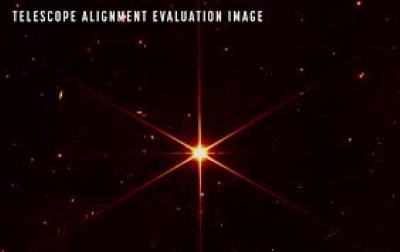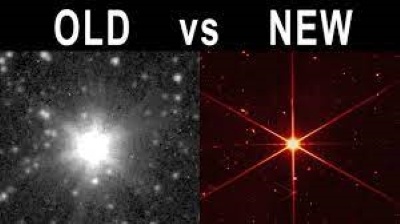The Webb Telescope in our headline refers to the James Webb Space Telescope. We’ve introduced you to the accomplishments of this great technological advancement in earlier blogs. As you know, it was successfully launched at Christmas. Therefore, it is very fitting that it continues to perform admirably as we reach Easter and spring.
NASA’S Webb Telescope: Conquering Alignment with Optics Working Perfectly

Latest Information From the Webb Telescope: Our “Easter Star is 2000 Light-Years Away!”
You probably also know there is no specific “Easter” Star. However, NASA’s Webb Space Telescope team has received an amazing image of “the star known to astronomers as 2MASS J17554042+6551277.” Here at ER Precision Optics, we thought we would just call it an Easter star. Why? Because Webb got this image in the spring. This blog also calls it the Easter Star because this blog brings Spring greetings from our ER Precision Optics family to you.
Bright Star Illuminates NASA’S Webb Telescope Image
The image captured by the Webb Space Telescope has beauty and clarity. But it was actually a test, not an exercise in art or inspiration. From the exquisite image, we discovered many facts.
Below, check out a few basics about the simple star which is now immortalized by being our first image at such distance.
1. Our Easter Star, number 2MASS J17554042+6551277 is like a gift from the universe. It shines 16 times brighter than our sun.
2. Optics experts consider it close to us. It’s only about 2,000 light-years away.
3. It is also only one of “up to 400 billion stars in the Milky Way. And until recently, nobody gave it a lot of thought.” Now it is the oldest, furthest away star ever seen by humans.
Applause for Excellent Optics
The image and the data prompted a statement from Webb telescope experts at NASA. “Webb’s optical performance will be able to meet or exceed the science goals the observatory was built to achieve.”
The experts completed alignment called “fine phasing” to make the image possible.
This was a key stage in waking up and empowering Webb’s Optical Telescope Element. And NASA’s Webb experts had good news for us as we go about our lives here on earth.
Up there, in cold silent space, every “optical parameter that has been checked and evaluated and is performing at, or above, expectations.” They added, “The team also found no critical issues and no measurable contamination or blockages to Webb’s optical path.”
The Great Value of the Finely Phased OTE

An Old Star With a Brand New Home! Images By the Webb Telescope. (nasa.gov)
This is extremely important because “The Optical Telescope Element (OTE) is the eye of the James Webb Space Telescope Observatory.”
- First, it gathers the light coming from space and provides it to the science instruments.
- Secondly, “The OTE consists of the mirrors as well as structures and subsystems that support the optics.” Thus, now you know how the observatory gathers light from distant objects. Then it sends light to its instruments.
Why Take a Portrait of a Distant Star?
Although the image of the star is artful, that was not Webb’s intent in creating it. The reason for the historical photo was to exquisitely focus on the bright star for “alignment evaluation.”
Webb’s optics and NIRCam are extraordinarily sensitive. Thus, not only do you see the bright central star, but stars in the background of the photo also glimmer and gleam.
It’s All About Optics, Mirrors, and Light and Infrared Light
To make this happen, NASA’s Webb experts finally phased and adjusted all the mirror segments. We told you about that amazing mirror in our earlier Webb blog on this topic.
By using the NIRCam instrument, each of the primary mirror segments produces one unified image of the same star. This first image of a distant star testifies that the first-of-its-kind optical system on the space telescope is functioning at top precision.
NASA’S Webb and The Months Ahead

Images From the Webb Telescope Clearly Outshines the Older Hubble Technology. (NASA.gov)
As our lives go on here on earth, the team will complete more alignments. Soon, we will see more fine data from finely tuned instruments like the Near-Infrared Spectrograph.
Also coming online will be the Mid-Infrared Instrument. Likewise, we will see data from the Near InfraRed Imager and Slitless Spectrograph. Right now, the cooling team is in the hot seat. They are gently reducing the temperature so the above instruments can focus and function in their favored freezing temperatures.
Spring Brings a Cold Easter for Webb’s Instruments
And when we say these instruments thrive in the cold, we mean really cold.
First Step: “Along with Webb’s three other instruments, MIRI initially cooled off in the shade of Webb’s tennis-court-size sun shield, dropping to about 90 kelvins (minus 298 F, or minus 183 C).
Second Step: “But dropping to less than 7 kelvins required an electrically powered cryocooler.” It was only last week, that the team passed the “pinch point.”
That happened when MIRI went from 15 kelvins (minus 433 F, or minus 258 C) to 6.4 kelvins (minus 448 F, or minus 267 C). That’s pretty cold for the Easter Season! But the critical chilling went perfectly, according to all results.
NASA’s Web experts will finish fine-tuning and aligning all the instruments. Then we can look forward to thousands of images from the James Webb Space Telescope images.
Our Spring Wishes for You

Happy Easter and Spring Greetings to All Our Readers.
Once again, we wish you Happy Easter and Happy Spring– from all of us at ER Precision Optics. And remember, you do not have to have telescopic optics to glance up at the peaceful stars once in a while.
Enjoy your time with friends and family.


